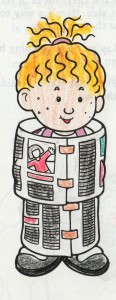
Insects, including grasshoppers, have an outer covering on their bodies called an exoskeleton. This covering protects their soft bodies, gives it support, and shape. A newly formed grasshopper eats and its body grows larger. But the exoskeleton never changes size. When the exoskeleton gets too tight, it splits and the grasshopper wiggles out. The grasshopper has a new flexible covering over its body that will dry to form a new exoskeleton. To increase the size of the exoskeleton, the grasshopper puffs its body up as much as possible. When the exoskeleton has dried, the grasshopper deflates its body resulting in the exoskeleton being bigger so that the grasshopper has room to grow. The shedding of the exoskeleton is called molting.
It takes 40 to 60 days for young grasshoppers to become adults. During this time they molt up to six times. After the last molt they have wings.

You can use newspaper and tape to model molting.
Discover For Yourself
1. Wrap two layers of newspaper around the body of a child. One layer is around the chest and the second layer around the hips. Use tape to secure each layer of paper. FYI: You may need to tape several sheets together, depending on body size.

2. Hold a cookie to the mouth of the child inside the newspaper covering. Instruct the child to take a bite of the cookie, then pretend to grow by moving your arms and pushing out on the paper. The paper around your chest will tear apart, but the paper around your hips may stay together.
3. Allow the paper to fall, then step out of the paper.
The fallen paper represents a shed exoskeleton.
The book is designed to help young students catch the “science bug”
Teaching the Fun of Science to Young Learners
The book’s 75 lessons and reproducible activities touch on all areas of science and provide the key to a world of science magic and mystery. While kids will have fun doing the activities and learning to love science, they are also being encouraged to develop other skills, including reading, writing, math, and art.
(Paid Link)
